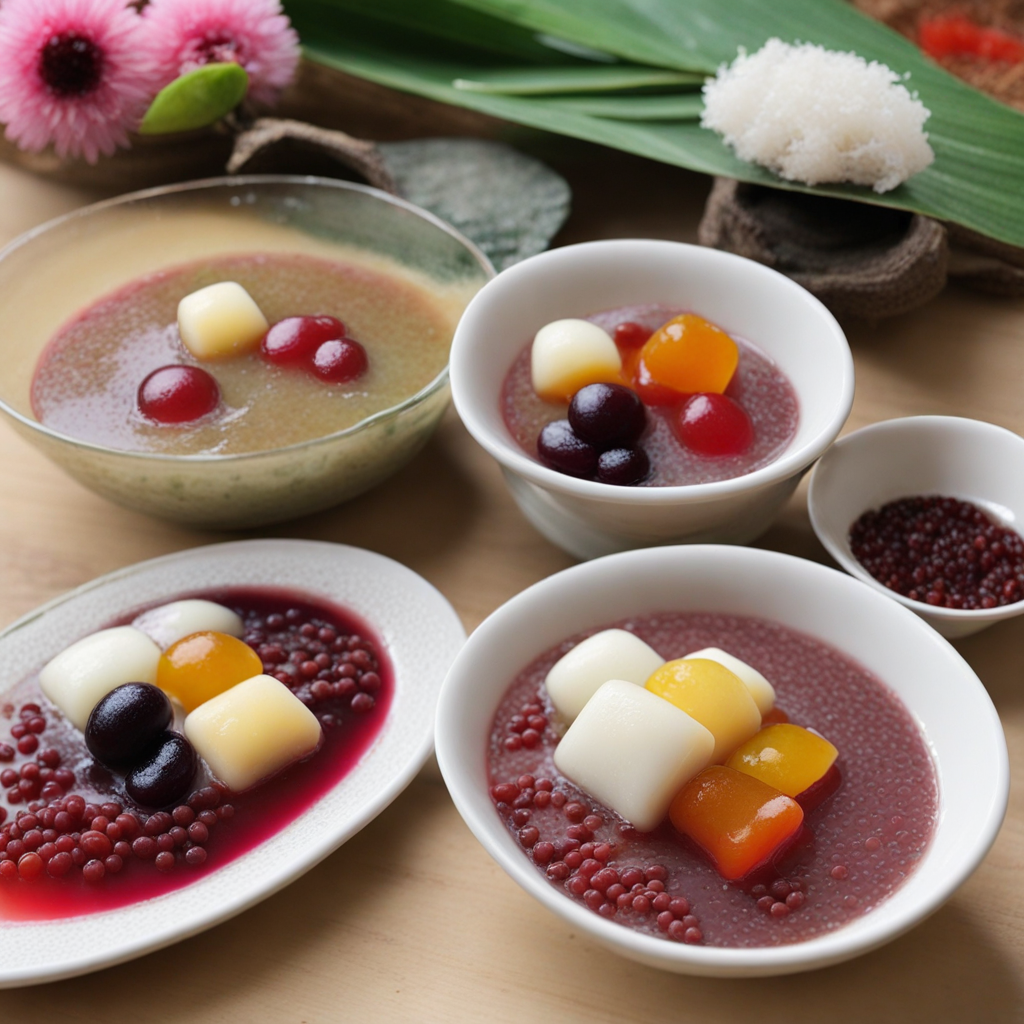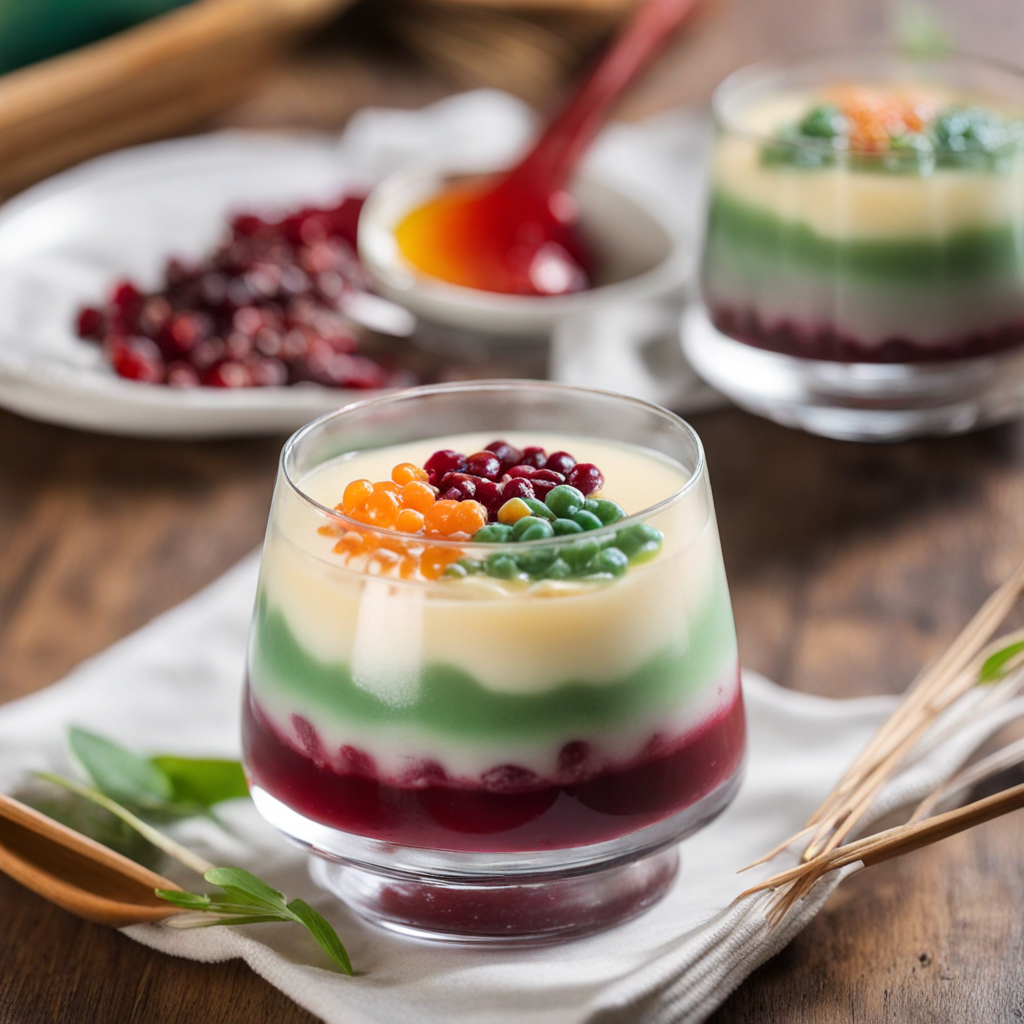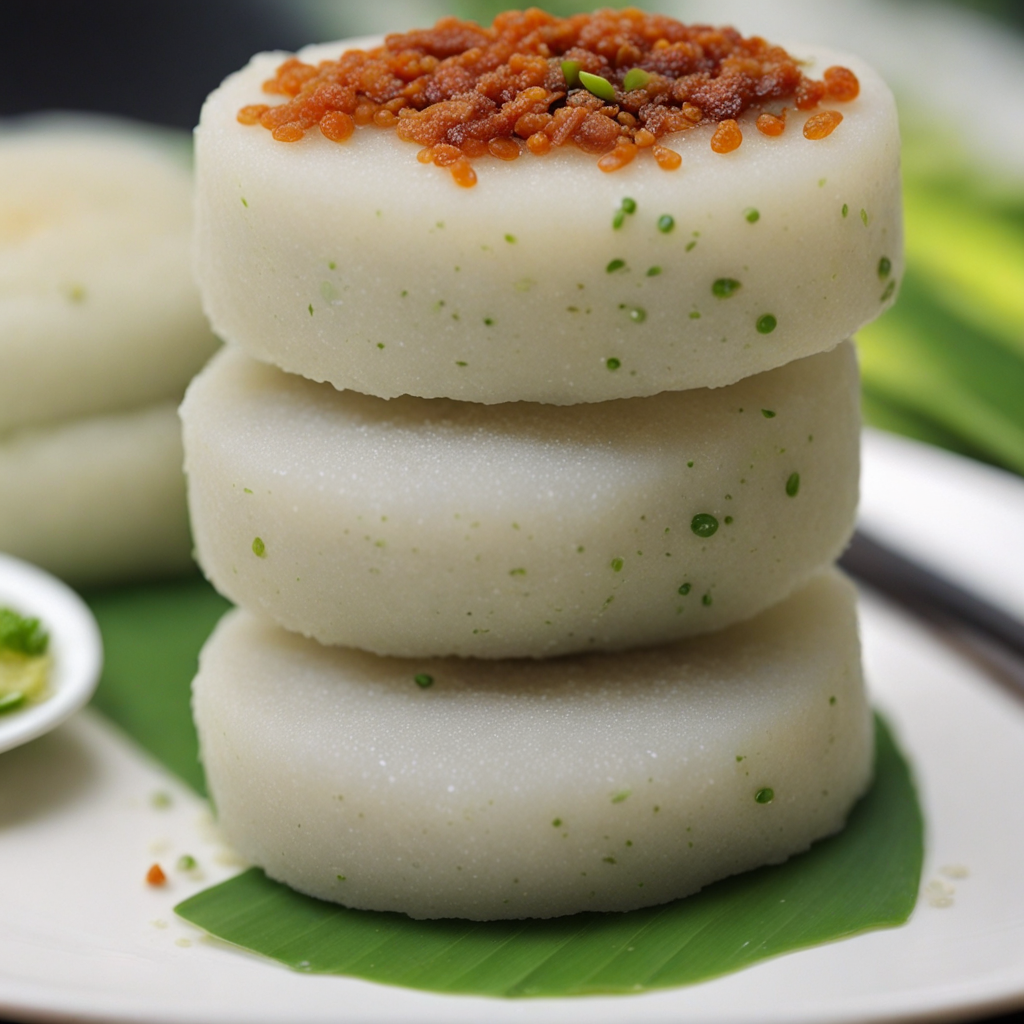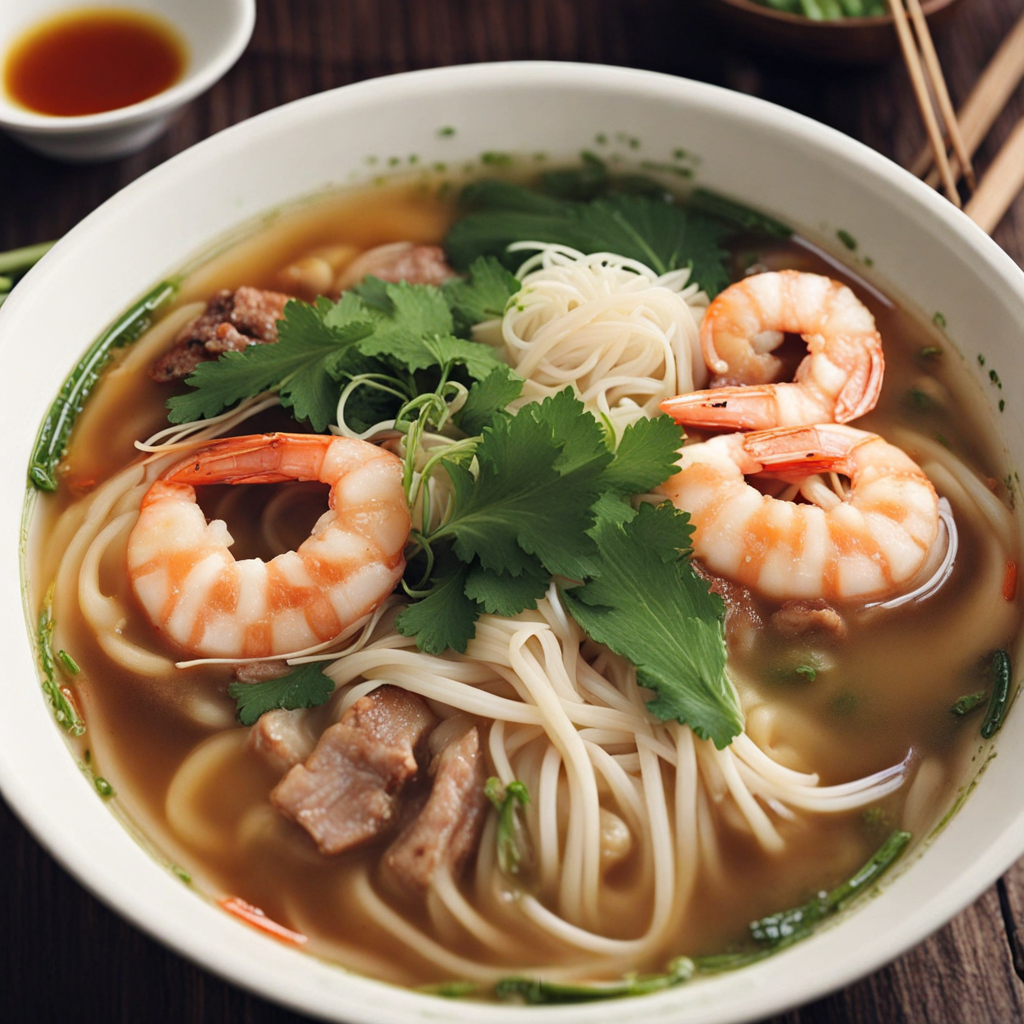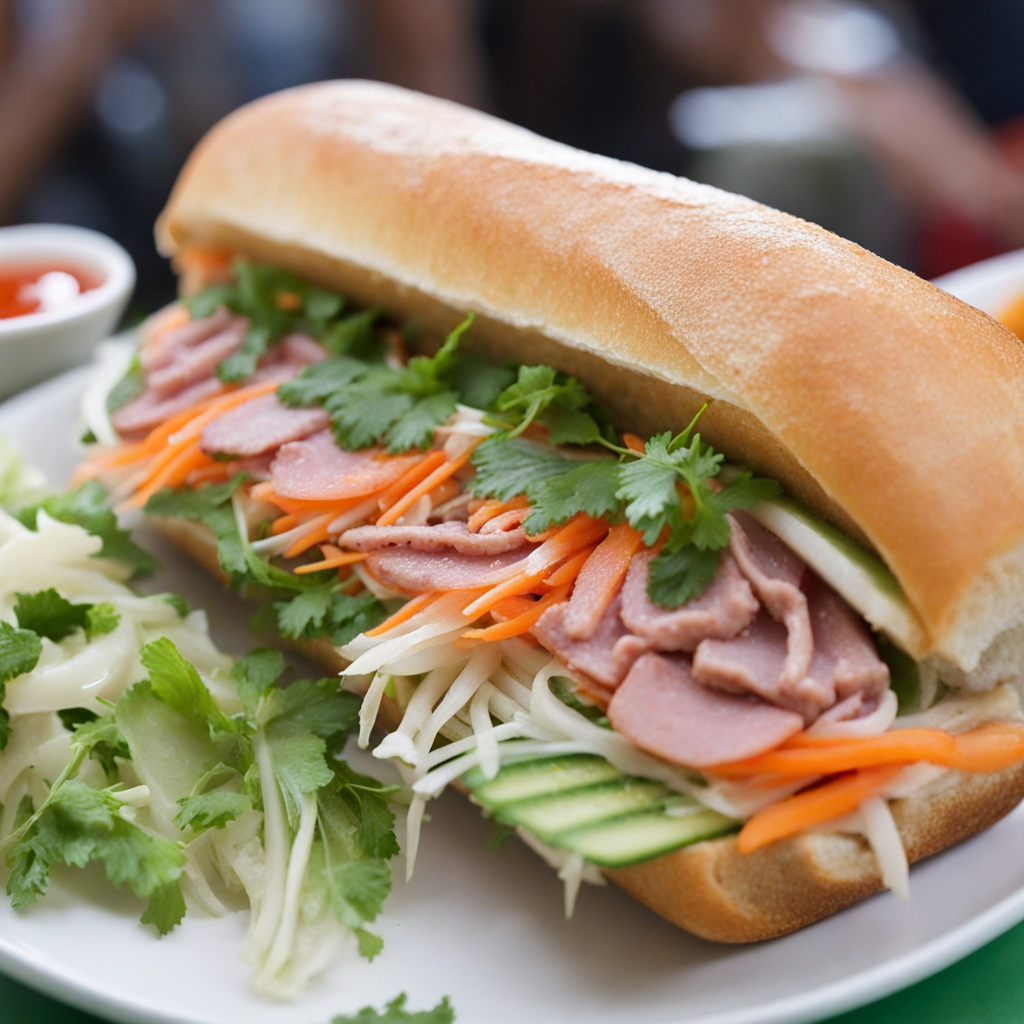Che Ba Mau
Che Ba Mau, also known as "Three Color Dessert," is a vibrant and visually stunning dish hailing from Vietnam. This delightful treat is a harmonious combination of sweet mung bean paste, rich coconut milk, and colorful layers of various ingredients, typically including red beans, green pandan jelly, and yellow mung bean pudding. Each layer is distinct in flavor and texture, creating a delightful experience with every spoonful. The dessert is served chilled, making it a refreshing option, especially in the warm tropical climate of Vietnam. At the core of Che Ba Mau's appeal is the balance of flavors and textures. The sweet and creamy coconut milk envelops the soft, slightly chewy mung bean and jelly layers, while the red beans add a slight earthiness to the mix. The vibrant colors not only make it visually appealing but also invite an exploration of different tastes. The pandan jelly, made from fragrant pandan leaves, adds a unique herbal note, while the mung bean pudding provides a comforting, creamy consistency that ties the dish together. Traditionally enjoyed as a street food snack or dessert, Che Ba Mau is often garnished with a sprinkle of crushed ice and sometimes topped with toasted coconut flakes for added texture. It embodies the essence of Vietnamese dessert culture, emphasizing fresh ingredients and a balance of sweetness without being overly sugary. This delightful treat is perfect for those looking to explore new flavors and indulge in the rich culinary heritage of Vietnam.
How It Became This Dish
The Sweet Mosaic: A Journey Through the History of Chè Ba Màu Chè Ba Màu, which translates to "Three-Color Dessert," is a beloved Vietnamese sweet treat that encapsulates the vibrant culinary traditions of the country. This dessert is not just a delight for the taste buds; it is an emblem of cultural heritage and social gatherings, a symbol of summer, and a reflection of Vietnam's rich history. #### Origins of Chè Ba Màu The exact origins of Chè Ba Màu are not definitively documented, but it is widely believed to have emerged in southern Vietnam, particularly in the bustling streets of Ho Chi Minh City (formerly Saigon). The dessert's roots can be traced back to the broader category of "chè," a term that encompasses a wide variety of Vietnamese desserts, often made with beans, fruits, and glutinous rice. Historically, the use of beans and grains in Vietnamese desserts can be linked to the agricultural practices of the region. Rice, mung beans, and black-eyed peas have been staples in Vietnamese cuisine for centuries, cultivated in the fertile Mekong Delta. The innovation of combining these ingredients with coconut milk and sugar to create a visually appealing and flavorful dessert likely arose from a desire to celebrate local produce and the communal spirit of Vietnamese society. The three colors of Chè Ba Màu symbolize harmony and balance, reflecting the Vietnamese philosophy of the interconnectedness of nature and humanity. Traditionally, the colors come from green mung beans, yellow mung beans or sweet potato, and red beans or jelly, representing the yin and yang of life. Each ingredient not only adds to the aesthetic appeal but also carries its own cultural significance, making Chè Ba Màu a dessert rich in symbolism. #### Cultural Significance Chè Ba Màu plays a significant role in Vietnamese culture. It is often served during festivals, family gatherings, and special occasions, making it a symbol of togetherness and celebration. The dessert is particularly popular during the hot summer months, providing a refreshing respite from the sweltering heat. Street vendors in cities like Ho Chi Minh City and Hanoi often prepare Chè Ba Màu, serving it in colorful cups to passersby, which adds to its accessibility and popularity. Moreover, Chè Ba Màu is often enjoyed during the Lunar New Year (Tết), a time for family reunions and honoring ancestors. The dessert’s vibrant colors and sweet flavors evoke feelings of joy and prosperity, making it a fitting choice for the celebrations. During Tết, families may also prepare variations of Chè Ba Màu, incorporating seasonal ingredients or family recipes, further deepening its cultural ties. In addition to its festive significance, Chè Ba Màu embodies the essence of Vietnamese hospitality. Offering a bowl of this colorful dessert to guests is a way to show affection and warmth, reinforcing social bonds. In a country where food is deeply intertwined with relationships, Chè Ba Màu stands as a testament to the importance of shared experiences. #### Development Over Time As Vietnam has evolved, so too has the preparation and presentation of Chè Ba Màu. In the early 20th century, the dessert was relatively simple, primarily consisting of its core ingredients: mung beans, sugar, and coconut milk. However, as culinary influences began to flow into Vietnam from various regions and cultures, Chè Ba Màu adapted and transformed. Post-war Vietnam, particularly in the late 20th century, witnessed significant changes in the country’s culinary landscape. The influx of international influences, particularly from neighboring countries like Thailand, where coconut milk desserts are prevalent, introduced new ideas and ingredients into the traditional Vietnamese dessert repertoire. This led to the incorporation of new components into Chè Ba Màu, such as various jellies, fruits, and even ice cream, creating an ever-evolving dessert that maintains its core identity while embracing innovation. The globalization of cuisine in the 21st century has further popularized Chè Ba Màu beyond the borders of Vietnam. Vietnamese diaspora communities around the world have brought the dessert to international attention, often serving it in Vietnamese restaurants and cafes. The vibrant colors and unique textures of Chè Ba Màu have caught the eye of food enthusiasts and adventurers, leading to its inclusion in food festivals and culinary events globally. Additionally, social media has played a pivotal role in the resurgence of interest in traditional Vietnamese desserts, including Chè Ba Màu. Instagram and TikTok have allowed food lovers to showcase their culinary creations, sparking a viral interest in visually appealing dishes. As a result, Chè Ba Màu has gained a new generation of fans who appreciate not only its taste but also its artistic presentation. #### Conclusion: A Dessert of Many Layers Chè Ba Màu is more than just a sweet dish; it is a narrative woven into the fabric of Vietnamese culture and history. Its evolution from a simple, traditional dessert to a globally recognized symbol of Vietnamese culinary heritage illustrates the adaptability and resilience of Vietnamese cuisine. Each layer of mung bean, each splash of coconut milk, and each sprinkle of crushed ice tells a story of community, celebration, and the beauty of shared experiences. Today, Chè Ba Màu continues to delight locals and travelers alike, inviting everyone to partake in its colorful history. Whether enjoyed in a bustling street stall in Ho Chi Minh City or presented at a family gathering, Chè Ba Màu serves as a delicious reminder of the rich tapestry of flavors and traditions that define Vietnamese culture. As the world continues to embrace diverse culinary traditions, Chè Ba Màu stands as a testament to the enduring power of food in bringing people together, transcending borders, and celebrating life’s sweetest moments.
You may like
Discover local flavors from Vietnam


